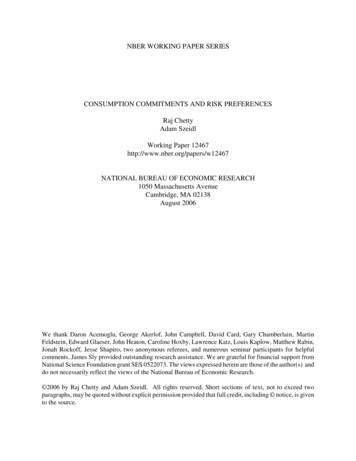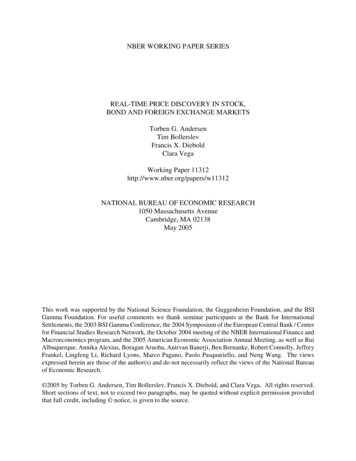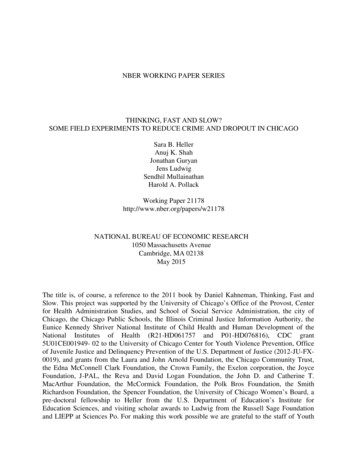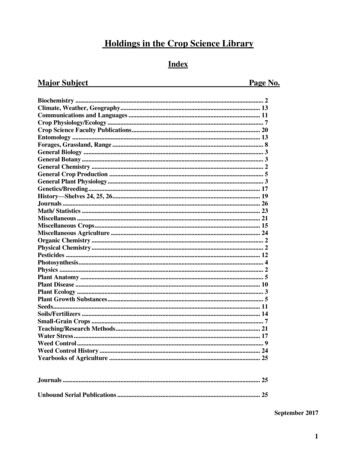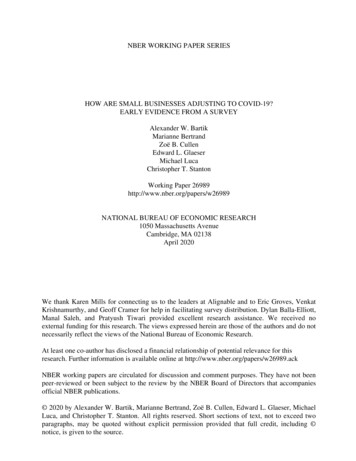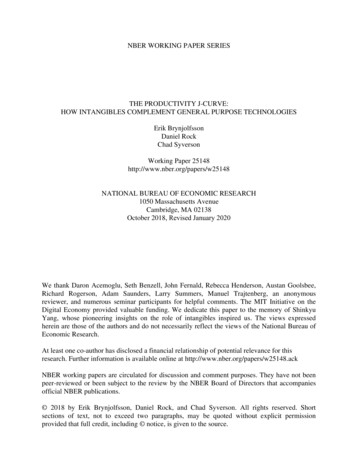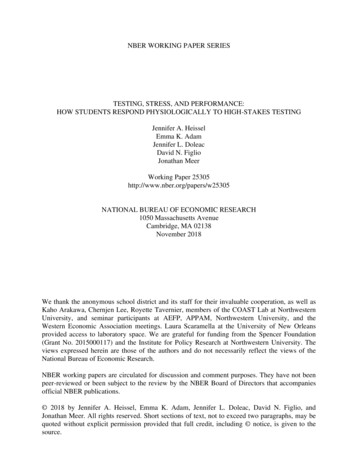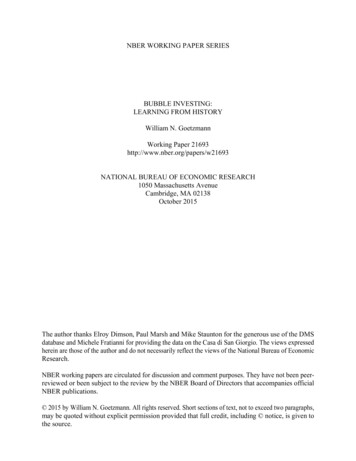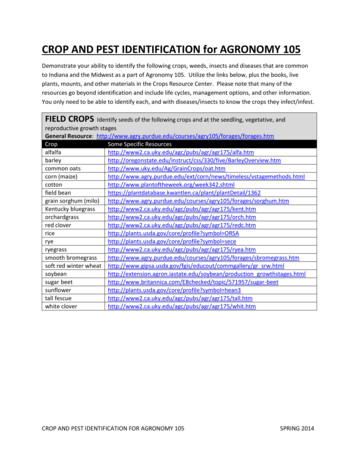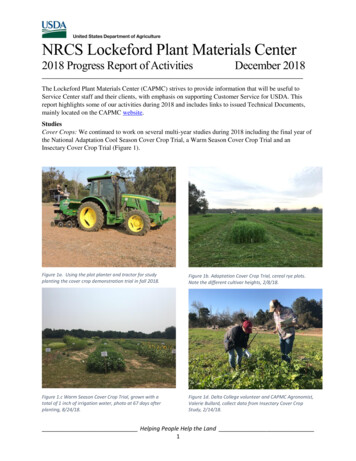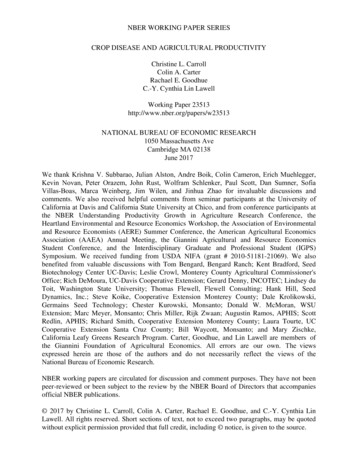
Transcription
NBER WORKING PAPER SERIESCROP DISEASE AND AGRICULTURAL PRODUCTIVITYChristine L. CarrollColin A. CarterRachael E. GoodhueC.-Y. Cynthia Lin LawellWorking Paper 23513http://www.nber.org/papers/w23513NATIONAL BUREAU OF ECONOMIC RESEARCH1050 Massachusetts AveCambridge MA 02138June 2017We thank Krishna V. Subbarao, Julian Alston, Andre Boik, Colin Cameron, Erich Muehlegger,Kevin Novan, Peter Orazem, John Rust, Wolfram Schlenker, Paul Scott, Dan Sumner, SofiaVillas-Boas, Marca Weinberg, Jim Wilen, and Jinhua Zhao for invaluable discussions andcomments. We also received helpful comments from seminar participants at the University ofCalifornia at Davis and California State University at Chico, and from conference participants atthe NBER Understanding Productivity Growth in Agriculture Research Conference, theHeartland Environmental and Resource Economics Workshop, the Association of Environmentaland Resource Economists (AERE) Summer Conference, the American Agricultural EconomicsAssociation (AAEA) Annual Meeting, the Giannini Agricultural and Resource EconomicsStudent Conference, and the Interdisciplinary Graduate and Professional Student (IGPS)Symposium. We received funding from USDA NIFA (grant # 2010-51181-21069). We alsobenefited from valuable discussions with Tom Bengard, Bengard Ranch; Kent Bradford, SeedBiotechnology Center UC-Davis; Leslie Crowl, Monterey County Agricultural Commissioner'sOffice; Rich DeMoura, UC-Davis Cooperative Extension; Gerard Denny, INCOTEC; Lindsey duToit, Washington State University; Thomas Flewell, Flewell Consulting; Hank Hill, SeedDynamics, Inc.; Steve Koike, Cooperative Extension Monterey County; Dale Krolikowski,Germains Seed Technology; Chester Kurowski, Monsanto; Donald W. McMoran, WSUExtension; Marc Meyer, Monsanto; Chris Miller, Rijk Zwaan; Augustin Ramos, APHIS; ScottRedlin, APHIS; Richard Smith, Cooperative Extension Monterey County; Laura Tourte, UCCooperative Extension Santa Cruz County; Bill Waycott, Monsanto; and Mary Zischke,California Leafy Greens Research Program. Carter, Goodhue, and Lin Lawell are members ofthe Giannini Foundation of Agricultural Economics. All errors are our own. The viewsexpressed herein are those of the authors and do not necessarily reflect the views of theNational Bureau of Economic Research.NBER working papers are circulated for discussion and comment purposes. They have not beenpeer-reviewed or been subject to the review by the NBER Board of Directors that accompaniesofficial NBER publications. 2017 by Christine L. Carroll, Colin A. Carter, Rachael E. Goodhue, and C.-Y. Cynthia LinLawell. All rights reserved. Short sections of text, not to exceed two paragraphs, may be quotedwithout explicit permission provided that full credit, including notice, is given to the source.
Crop Disease and Agricultural ProductivityChristine L. Carroll, Colin A. Carter, Rachael E. Goodhue, and C.-Y. Cynthia Lin LawellNBER Working Paper No. 23513June 2017JEL No. Q00,Q10,Q12ABSTRACTCrop diseases and how they are managed can have a large impact on agricultural productivity.This paper discusses the effects on agricultural productivity of Verticillium dahliae, a soil bornefungus that is introduced to the soil via infested spinach seeds and that causes subsequent lettucecrops to be afflicted with Verticillium wilt. We use a dynamic structural econometric model ofVerticillium wilt management for lettuce crops in Monterey County, California to examine theeffects of Verticillium wilt on crop-fumigation decisions and on grower welfare. We also discussour research on the externalities that arise with renters, and between seed companies and growersdue to Verticillium wilt, as these disease-related externalities have important implications foragricultural productivity.Christine L. CarrollCollege of AgricultureCSU Chico940 West First StreetChico, CA 95929clcarroll@csuchico.eduRachael E. GoodhueUniversity of California at DavisAgricultural and Resource EconomicsOne Shields AvenueDavis, CA 95616goodhue@primal.ucdavis.eduColin A. CarterUniversity of California at DavisAgricultural and Resource EconomicsOne Shields AvenueDavis, CA 95616colin@primal.ucdavis.eduC.-Y. Cynthia Lin LawellUniversity of California at DavisAgricultural and Resource EconomicsOne Shields AvenueDavis, CA 95616cclin@primal.ucdavis.edu
1IntroductionCrop diseases can have a large impact on agricultural productivity. Invasive plant pathogens,including fungi, cause an estimated 21 billion in crop losses each year in the United States(Rossman, 2009).Verticillium dahliaeis a soil borne fungus that is introduced to the soilvia infested spinach seeds and that causes subsequent lettuce crops to be a icted withVerticillium wilt (V. wilt). Lettuce is an important crop in California, and the majority ofthe lettuce production in the United States occurs in California. The value of California'slettuce crop was 1.7 billion in 2013 (National Agricultural Statistics Service, 2015).How crop diseases are managed can have a large impact on agricultural productivityas well.V. wilt can be prevented or controlled by the grower by fumigating with methylbromide, planting broccoli (a low-return crop), or not planting spinach. These control optionsentail incurring costs or foregoing pro t in the current period for future bene t. V. wilt canalso be prevented or controlled by the spinach seed company by testing and cleaning thespinach seeds. However, seed companies are unwilling to test or clean spinach seeds, as theyare not a ected by this disease.This paper analyzes the e ects of V. wilt on agricultural productivity. In particular,we use a dynamic structural econometric model of V. wilt management for lettuce crops inMonterey County, California to examine the e ects of V. wilt on crop-fumigation decisionsand on grower welfare.We also discuss our research on the externalities that arise withrenters, and between seed companies and growers due to V. wilt, as these disease-relatedexternalities have important implications for agricultural productivity.We use a dynamic model for several reasons. First, the control options (fumigation,planting broccoli, and not planting spinach) require incurring costs or foregoing pro t in thecurrent period for possible future bene t, and are thus are best modeled with a dynamicmodel.2 Second, because cropping and fumigation decisions are irreversible (as is the damage2 Some of these actions may also generate bene ts in the current period for the current crop. For example,in addition to being an investment in protecting potential future lettuce crops from V. wilt, methyl bromide1
from V. wilt), because the rewards from cropping and fumigation decisions are uncertain,and because growers have leeway over the timing of cropping and fumigation decisions, thereis an option value to waiting which requires a dynamic model (Dixit and Pindyck, 1994).Third,Verticillium dahliaetakes time to build up in the soil, and once present, persists formany years.There are several advantages to using a dynamic structural model to model grower cropand fumigation decisions. First, unlike reduced-form models, a structural approach explicitlymodels the dynamics of crop and fumigation decisions by incorporating continuation valuesthat explicitly model how expectations about the future a ect current decisions.A second advantage of the structural model is that we are able to estimate the e ect ofeach state variable on the expected payo s from di erent crop and fumigation choices, andare therefore able to estimate parameters that have direct economic interpretations.Thedynamic model accounts for the continuation value, which is the expected value of the valuefunction next period. With the structural model we are able to estimate parameters in thepayo s from di erent crop and fumigation choices, since we are able to structurally modelhow the continuation values relate to the payo s from the crop and fumigation choices.A third advantage of our structural model is that we can use the parameter estimatesfrom our structural model to simulate the e ects of crop disease on agricultural productivity.In particular, we run counterfactual simulations to analyze the e ects of V. wilt on cropfumigation decisions and on grower welfare.The balance of this paper proceeds as follows. Section 2 provides background on theCalifornia lettuce industry, V. wilt, and options to control the disease. Section 3 is a briefreview of the relevant literature.Section 4 describes our dynamic structural econometricmodel. Section 5 describes our data. We present our results in Section 6 and our counterfactual simulations in Section 7. Section 8 concludes.can also be bene cial to the current crop of strawberries. However, on net, these control options generallyrequire incurring net costs or foregoing pro t in the current period.2
2BackgroundCalifornia, a major agricultural producer and global trader, sustains signi cant economicdamage from invasive plant pathogens.Fungi damage a wide variety of California crops,resulting in yield- and quality-related losses, reduced exportability, and increased fungicideexpenditures (Palm, 2001).Measured by value, lettuce ranks in the top ten agricultural commodities producedin California (National Agricultural Statistics Service, 2015). Much of California's lettucecrop is grown in Monterey County, where lettuce production value is 27% of the county'sagricultural production value (Monterey County Agricultural Commissioner, 2015). Approximately ten to fteen thousand acres are planted to lettuce in Monterey County each season(spring, summer, and fall). Spinach, broccoli, and strawberries are also important crops inthe region.Verticillium dahliaeis a soil borne fungus that causes lettuce to be a icted with V.wilt. No e ective treatment exists once plants are infected by the fungus (Xiao and Subbarao,1998; Fradin and Thomma, 2006). The fungus can survive in the soil for fourteen years asmicrosclerotia, which are resting structures that are produced as the pathogen colonizesa plant.This system allows the fungus to remain in the soil even without a host plant.When a susceptible host is planted, microsclerotia attack through the roots, enter the waterconducting tissue, and interfere with the water uptake and transport through the plant. Ifthe density of microsclerotia in the soil passes a threshold, a disease known as V. wilt occurs.Lactuca sativaV. wilt rst killed a lettuce (L.) crop in California's Parajo Valley in1995. Prior to 1995, lettuce was believed to be immune. Since then, the disease has spreadrapidly through the Salinas Valley, the prime lettuce production region of California.By2010, more than 150 elds were infected with V. wilt (Atallah, Hayes, and Subbarao, 2011),33 As not all the elds that were infected by 2010 were known at the time Atallah, Hayes, and Subbarao(2011) was published, the number of elds a ected by 2010 elds was actually even higher, numbering over175 elds (Krishna Subbarao, personal communication, 2013).3
amounting to more than 4,000 acres (Krishna Subbarao, personal communication, 2013).4Although growers have resisted reporting the extent of the disease since 2010, it is likelythat the number of a ected acres has increased since then (Krishna Subbarao, personalcommunication, 2013).Verticillium dahliaeis introduced to the soil in three possible ways. First, V. wilt canbe spread locally from eld to eld by workers or equipment. Local spread is a relativelyminor contributor, however, and growers have taken steps to mitigate this issue themselves,for example by cleaning equipment before moving between elds.Second, V. wilt is introduced to the soil via infested lettuce seeds. However, studies ofcommercial lettuce seed lots from around the world show that fewer than 18% tested positiveforVerticillium dahliaeand, of those, the maximum incidence of infection was less than 5%(Atallah, Hayes, and Subbarao, 2011). These relatively low levels do not cause V. wilt inlettuce at an epidemic level. Models of the disease suggest that it would be necessary forlettuce seed to have an incidence of infection of at least 5% and be planted back to back forthree to ve seasons in order for the disease to appear, with at least ve subsequent seasonsrequired for the high disease levels currently seen (Atallah, Hayes, and Subbarao, 2011).Third, V. wilt is introduced to the soil via infested spinach seeds. Spinach seeds havebeen shown to be the main source of the disease (du Toit, Derie, and Hernandez-Perez, 2005;Short, D.P.G. et al., 2015); 89% of spinach seed samples are infected, with an incidence ofinfected seeds per sample of mean 18.51% and range 0.3% to 84.8% (du Toit, Derie, andHernandez-Perez, 2005). The precise impact of planting infected spinach seeds on V. wiltof lettuce was recently assessed and proven to be the cause of the disease on lettuce (Short,D.P.G. et al., 2015). The pathogen isolated from infected lettuce plants is genetically identicalto the pathogen carried on spinach seeds (Atallah et al., 2010).Infected spinach seeds carry an average of 200 to 300 microsclerotia per seed (Maruthacha-4 Krishna Subbarao is a Professor of Plant Pathology and Cooperative Extension Specialist at the University of California at Davis. He has studied V. wilt for many years.4
lam et al., 2013). As spinach crops are seeded at up to nine million seeds per hectare forbaby leaf spinach, even a small proportion of infected seeds can introduce many microsclerotia (du Toit and Hernandez-Perez, 2005).One method for controlling V. wilt is to fumigate with methyl bromide. As methylbromide is an ozone depleting substance, the Montreal Protocol has eliminated methyl bromide use for fumigation of vegetable crops such as lettuce; however, certain crops such asstrawberries have received critical-use exemptions through 20165 (California Department ofPesticide Regulation, 2010; United States Environmental Protection Agency, 2012b), andthe residual e ects from strawberry fumigation provide protection for one or two seasonsof lettuce before microsclerotia densities rise (Atallah, Hayes, and Subbarao, 2011).Thelong-term availability of this solution is limited and uncertain.A second method for controlling V. wilt is to plant broccoli. Broccoli is not susceptibleto V. wilt and it also reduces the levels of microsclerotia in the soil (Subbarao and Hubbard,1996; Subbarao, Hubbard, and Koike, 1999; Shetty et al., 2000). Some growers have experimented with this solution, but relatively low returns from broccoli in the region prevent thisoption from becoming a widespread solution. Planting all infected acreage to broccoli mayalso ood the market, driving down broccoli prices.A third method for controlling V. wilt is to not plant spinach, since spinach seeds arethe vector of pathogen introduction (du Toit, Derie, and Hernandez-Perez, 2005). Growerswho use this third control method of not planting spinach must forgo any relative pro tsthey may have received if they planted spinach instead of another crop.In addition to the control measures that the grower can take, V. wilt can also be prevented or controlled by a spinach seed company through testing and cleaning the spinach5 Critical-useexemption requests through 2014 specify that up to one third of the California strawberrycrop will be fumigated with methyl bromide, but actual use was much lower. The remainder of the crop istreated with alternatives such as chloropicrin or 1,3-Dichloropropene (1,3-D) (United States EnvironmentalProtection Agency, 2012a). However, these alternatives (unless combined with methyl bromide) tend to beless e ective for V. wilt (Atallah, Hayes, and Subbarao, 2011). Field trials of other chemical fumigants eitherhave not been widely used due to township caps or are not yet registered and approved.5
seeds. Testing or cleaning seeds is an important option for preventingVerticillium dahliaefrom being introduced into a eld, but can be uncertain and potentially costly. AlthoughVerticillium dahliaecannot be completely eliminated by seed cleaning, incidence levels inspinach seed can be signi cantly reduced (du Toit and Hernandez-Perez, 2005). Very recentdevelopments in testing procedures suggest that testing spinach seed formight soon be feasible on a commercial basis.up testing spinach seeds. Previously, testing forVerticillium dahliaeMoreover, a very recent innovation speedsVerticillium dahliaein spinach seeds tookapproximately two weeks and could not accurately distinguish between pathogenic and nonpathogenic species (Duressa et al., 2012). This new method takes only one day to complete,is highly sensitive (as it is able to detect one infected seed out of 100), and can distinguishamong species (Duressa et al., 2012).V. wilt can also be controlled by restricting the imports of spinach seeds infested withVerticillium dahliae,but doing so would have trade implications.Currently, the UnitedStates has no phytosanitary restrictions on spinach seed imports, but Mexico prohibits theimportation of seeds if more than 10% are infected (IPC, 2003).V. wilt can therefore be prevented or controlled by the grower by fumigating withmethyl bromide, planting broccoli, or not planting spinach. These control options requirelong-term investment for future gain.V. wilt can also be prevented or controlled by thespinach seed company by testing and cleaning the spinach seeds. However, seed companiesare unwilling to test or clean spinach seeds, as they are not a ected by this disease.3Literature ReviewThe rst strand of literature to which our paper relates is on the economics of pest management (Hueth and Regev, 1974; Carlson and Main, 1976; Wu, 2001; Noailly, 2008; McKeeet al., 2009), which focuses on pests for which treatment is available after crops are a ected.In contrast, V. wilt cannot be treated once crops are a ected. Existing work on crop disease,6
such as Johansson et al. (2006) and Gomez, Nunez, and Onal (2009) on soybean rust, andAtallah et al. (2015) on grapevine leafroll disease, focuses on spatial issues regarding thespread of the disease. In contrast, V. wilt has only a limited geographic impact, and thusdynamic considerations are more important than spatial ones for V. wilt.A second strand of literature to which our paper relates is on dynamic models inagricultural management.AsVerticillium dahliaepersists in the soil for many years, astatic model such as that proposed by Mo tt, Hall, and Osteen (1984) will not properlyaccount for the future bene ts of reducing microsclerotia in the soil. The dynamics of V.wilt more closely t the seed bank management model by Wu (2001).Dynamic models have been used in agricultural management to analyze many problems. Weisensel and van Kooten (1990) use a dynamic model of growers' choices to plantwheat, or to use tillage fallow versus chemicals to store moisture. In a related paper, vanKooten, Weisensel, and Chinthammit (1990) use a dynamic model that explicitly includessoil quality in the grower's utility function and the trade-o between soil quality (which maydecline due to erosion) and net returns.Our paper builds on the literature on dynamic structural econometric modeling. Rust's(1987; 1988) seminal papers develop a dynamic structural econometric model using nestedxed point maximum likelihood estimation.This model has been adapted for many ap-plications, including bus engine replacement (Rust, 1987), nuclear power plant shutdown(Rothwell and Rust, 1997), water management (Timmins, 2002), agriculture (De Pinto andNelson, 2009; Scott, 2013), air conditioner purchases (Rapson, 2014), wind turbine shutdowns and upgrades (Lin Lawell, 2017), and copper mining decisions (Aguirregabiria andLuengo, 2016). Carroll et al. (2017a) develop and estimate a dynamic structural model toanalyze short- versus long-term decision-making for disease control. Carroll et al. (2017b)develop and estimate a dynamic structural model to analyze the supply chain externalitybetween growers and spinach seed companies in controlling V. wilt.7
4Dynamic Structural Econometric ModelTo analyze the e ects of V. wilt on, we develop and estimate a single-agent dynamic structuraleconometric model using the econometric methods developed by Rust (1987). Each montht,each growerichooses an actiondit D.The possible actions for each grower for eachmonth include one of ve crops (resistant, susceptible (other than lettuce), lettuce, spinach,and broccoli), combined with the choice to fumigate with methyl bromide. To focus on thecrops most relevant to this problem, we group the crops resistant to V. wilt together and thecrops (other than lettuce) susceptible to V. wilt together. Lettuce, spinach, and broccoli areincluded separately as these crops are most relevant to V. wilt. Susceptible crops includestrawberries, artichoke, and cabbage. Resistant crops include cauli ower and celery.Although the raw data are observations on the day and time any fumigant is appliedon a eld, we aggregate to monthly observations. Growers are generally only making onecrop-fumigation decision each season. The length of the season varies among crops, and canbe as short as one month for spinach and more than a year for strawberries. For this reason,we choose a month as the time period for each crop-fumigation decision. To cover the caseof multi-month seasons, we include a dummy variable for whether the grower continues withthe same crop chosen in the previous month. Moreover, because not all crops are harvestedin all months, we also include dummy variables for each crop-month indicating whether aparticular month is a harvest month for a particular crop. For example, although MontereyCounty grows crops during a large portion of the year, few crops are harvested in the wintermonths.To estimate growers' losses from V. wilt, it would be ideal to observe actual prices,quantities, costs, and level of microsclerotia for both growers facing losses from V. wilt andthose who are not. In theory, pro t maximizing growers make optimal planting and fumigating decisions factoring in planting and input costs, as well as the costs of microsclerotiabuilding up in the soil over time and potentially impacting future crops. Unfortunately, data8
on growers' actual price, quantity, costs, and level of microsclerotia are not available.6We account for the important factors in a grower's pro t maximizing decision byincluding in the payo function state variables that a ect revenue; state variables that a ectcosts; state variables that a ect both revenue and costs; and state variables that a ect eitherrevenue or cost by a ecting the microsclerotia and the spread of V. wilt. The di erent statevariables we include may have e ects on price, yield, input costs, or microsclerotia levels.Costs are accounted for by the crop-fumigation dummies and the constant in our model,and we allow these costs to di er between the early and later periods of our data set. Thelargest cost di erence among crops is due to fumigation, so we include a dummy for methylbromide fumigation to account for the net costs of fumigation and to absorb cost di erencesamong crops.The per-period payo to a grower from choosing actionvalues of the state variablest.The state variablessitsitat timeat timettditat timetdepends on the it (dit )at timepriceit (dit )),dummyas well as the choice-speci c shockinclude crop prices for each crop (variables for each crop indicating whether this month is a harvest month for that cropharvest month dummyit (dit )), dummy variables for each crop indicating whether that crop(is the same as the crop chosen in the previous month (last crop dummyit (dit )),a variablemeasuring whether and how much the methyl bromide control option was used in the pastmethyl bromide historyit ),(and a variable measuring whether and how much the broccolibroccoli historyit ).control option was used in the past (There is a choice-speci c shock it (dit ) associated with each possible action itdenote the vector of choice-speci c shocks faced by growerD}.iThe vector of choice-speci c shocks itdit D.Leti at time t: it { it (dit ) dit is observed by groweriat timet,before growermakes his time-t action choice, but is never observed by the econometrician.The per-period payo to a grower from choosing action6 Theditat timetis given by:7University of California at Davis "Cost and Return Studies" have a limited number of estimatesfor the revenue and costs, but estimates are not available for all the crops and years in our model.7 Because the model requires discrete data, we bin the action and state variables. This means that there9
U (dit , sit , it , θ) π(dit , sit , θ) it (dit ),where the deterministic componentπ(·)of the per-period payo is given by:π(dit ,sit , θ) θ1 · spinach θ2 · methyldummyitbromide dummyit θ3 · broccolidummyit θ4 · (lettucedummyit * methyl bromide historyit ) θ5 · (lettucedummyit * broccoli historyit ) θ6 · (spinachdummyit *methyl bromide historyit ) θ7 · (spinachdummyit *broccoli historyit ) θ8 · lettucedummyit θ9 · (priceit (dit )* θ10 · last(1)harvest month dummyit (dit ))crop dummyit (dit ) θ11 ,wherespinach dummyit , methyl bromide dummyit , broccoli dummyit , and lettuce dummyit areamong the possible actionsdit D.Spinach will tend to increase microsclerotia, thus decreasing the quantity harvested,increasing microsclerotia costs, and potentially increasing input costs as growers need tofumigate more. The coe cientθ1on the spinach dummy captures the e ects of spinach onpayo s that are not internalized in the spinach price.Especially in more recent years, methyl bromide fumigation is very expensive andare no meaningful units associated with the variables, payo s, or value functions; and the payo and valuefunctions described in the model do not explicitly measure revenue or pro t. However, the payo functiondoes include action and state variables that a ect revenue (such as price); costs (such as the methyl bromidedummy); both revenue and costs; and either revenue and/or costs through their e ect on microsclerotia andthe spread of V. wilt.10
raises input costs dramatically. Fumigation is the largest cost di erence among crops. Thus,methyl bromide fumigation is a control option that requires incurring costs or forgoing pro tin the current period for future bene t. The coe cientθ2on the dummy for methyl bromidefumigation accounts for the costs of fumigation and absorbs the cost di erences amongcrops.8Broccoli is not highly pro table, but may yield future bene ts for lettuce growers.Thus, planting broccoli is a control option that requires incurring costs or forgoing pro t inthe current period for future bene t. The coe cientθ3on the broccoli dummy captures thee ects of broccoli on payo s that are not internalized in the broccoli price.Since the control options require incurring costs or forgoing pro t in the current periodfor future bene t, previous use of control options may a ect current payo s. We thereforeinclude variables indicating the fumigation history with methyl bromide within the last twelvemonths and the broccoli history within the last twelve months. We expect methyl bromidefumigation history and broccoli history to be closely linked to the presence of microsclerotiain a eld.Methyl bromide fumigation history and broccoli history will tend to decreasemicrosclerotia levels in the soil, leading to increased harvest for susceptible crops, lowermicrosclerotia costs, and lower input costs.We interact the variables measuring previous use of control options with a dummyvariable for lettuce being planted in the current period because lettuce is the primary susceptible crop.Methyl bromide fumigation history interacted with planting lettuce todaywould have a positive coe cientθ4if having fumigated with methyl bromide is an e ectivecontrol option. Similarly, broccoli history interacted with planting lettuce today would havea positive coe cientθ5if having planted broccoli is an e ective control option. These twoparameters therefore enable us to assess the e ectiveness of these two respective control8 Inaddition to being an investment in protecting potential future lettuce crops from V. wilt, methylbromide can also be bene cial to the current crop of strawberries. However, on net, methyl bromide fumigation generally requires incurring net costs or foregoing pro t in the current period. A negative sign onthe coe cient on the dummy for methyl bromide fumigation would indicate a net cost to methyl bromidefumigation.11
options.We also interact the methyl bromide history and broccoli history variables with thedummy variable for spinach being planted in the current period, to capture whether theundesirability of spinach is mitigated by having methyl bromide history and/or broccolihistory.Growers continue to plant lettuce even though it is susceptible, and the coe cientθ8on the lettuce dummy captures any additional bene t of lettuce beyond its price.Growers base decisions in part on the price or gross return they expect to receive fortheir harvested crops (Scott, 2013). We interact price with a dummy variable that is equal toone during the harvest season for each crop to capture the fact that although a grower mayplant the same crop for multiple months, he only receives revenue during the months of the9 In particular, the expected gross revenue to harvesting a cropharvest season for that crop.during non-harvest season months (e.g., during the winter) is 0.10 Thus, by incorporatingthe expected gross return in the payo of function and by modeling the dynamic decisionmaking of growers of when and what to plant, and whether and when to fumigate, our modelaccounts for the biological reality of how long a crop needs to be in the ground, because apro t maximizing grower is unlikely to pull out the crop before it is ready to harvest (andtherefore before he would receive the expected return), bar
Christine L. Carroll, Colin A. Carter, Rachael E. Goodhue, and C.-Y. Cynthia Lin Lawell NBER Working Paper No. 23513 June 2017 JEL No. Q00,Q10,Q12 ABSTRACT Crop diseases and how they are managed can have a large impact on agricultural productivity. This paper discusses the effects on agricultural productivity of Verticillium dahliae, a soil borne
